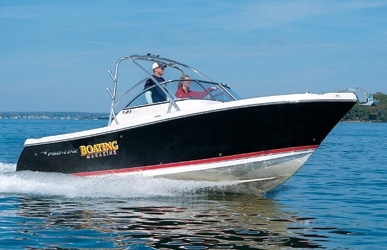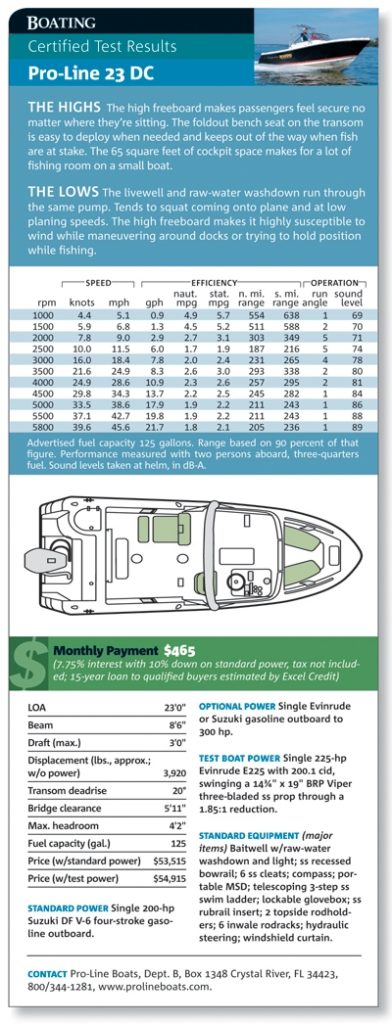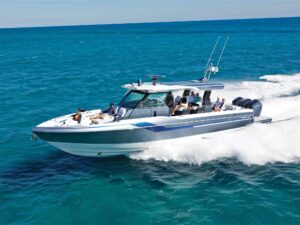
ProLine 23

ProLine 23 Specs
Three hours into my four-hour cruise from Block Island, Rhode Island, to Manhasset Bay, New York, I grew tired of feeling all 32 mph of our cruise speed hit me full in the face. I could feel the backs of my calves cramping, and my knees started to bark from battling the constant bay chop. At the helm of our Pro-Line 23 DC project boat, I did the sensible thing, though it’s an option not always afforded on small hardcore fishing boats: I sat down.
I’ve always been a center console guy, but spending time aboard the 23 DC helped me recognize two distinct advantages in owning this style boat. First off, on long cruises you can sit down, kick back, and enjoy the protection of a full windshield. Second, when you’re not fishing, double-console boats make it a hell of a lot easier to entertain the crew. What else did we learn? First and foremost, if you’re a fisherman with a family to please, the dual console is a more than viable small-boat option for ripping lips and tubing kids. But there’s a lot more to it than that. Here’s what else we found out about living with the 23 DC.
Package Deal
It’s a mystery to me why the dual console doesn’t rank higher as the family compromise boat. It’s terrible trying to fish off the typical stern drive bowrider and the center console’s layout — for all its utility — isn’t conducive to entertaining. There are a few competitors worth looking at. Falling below the 23 DC in price is the Trophy 2206 Dual Console ($43,855 with a 225-hp Mercury OptiMax). And coming in on the higher end of the dual console range is the Grady-White Tournament 225 ($72,425 with a Yamaha F225 outboard). The Trophy 2206 is 6″ shorter than the Pro-Line and carries 19 fewer gallons of fuel. The Grady-White is a full 10″ shorter with 6″ less beam and carries 29 fewer gallons of fuel. The Grady-White is the most rugged boat of the three (construction, materials, and fittings make up much of the price differential among all three boats), but the 23 DC has a few things going for it. For one, aboard the 23 DC, the livewell comes standard. The only problem with the setup is that the raw-water washdown is plumbed to the same pump, so to spray down your deck you have to turn on the livewell, switch a valve in the well to bypass it, and flow water to the washdown spigot. But on the flip side there’s just one through-hull, easily accessed in the bilge through an aft insole hatch. Underneath the hatch you’ll find tremendous access to the batteries and bilge pump, and you’ll be able to eyeball the oil reservoir to keep tabs on the level. All in all, the 23 DC is an easy boat to maintain.
Water access is superb aboard the 23 DC. The Grady-White has a bracket-mounted outboard on a closed transom. The Pro-Line has a transom walkthrough door to starboard that allows easy passage to the swim platform with its telescoping ladder and all-important grabhandle. (The Trophy has a more open transom but no walkthrough door.) You have no idea how much easier this makes getting in and out of the boat for watersports until you don’t have one. And Pro-Line offers an option that, if you’re going to go the dual console route, I think you pretty much have to get — a wakeboard tower ($2,146). Trophy also offers a tower for $2,793.
About that tower. If you’re going to compromise on a fishing boat for more family friendliness, you’re going to want one. Having the towline elevated makes wakeboarding, skiing, and tubing so much more pleasurable, it’s no contest compared to a towing eye or ski pylon. Plus, Pro-Line welds in two rocket launchers per side to accommodate trolling and make up for having only one rodholder per gunwale topside. Between the tower rocket launchers, the inwale rodholders, the 18-gallon livewell to port in the transom (Trophy comes with a 35-gallon one), and the two 60-gallon fishboxes under the bow cockpit seating, the 23 DC will appease the angler in you. Plus, the flat vertical dash has room for both a plotter/fishfinder and a stereo. We flush mounted a Garmin GPSMap 545s ($1,017, www.garmin.com) with a 5″ display. (You can read about the Garmin in a future electronics review.)
Two things drop the 23 DC from an A angling grade to a B+; with a dual console you lose some of the 360-degree fighting ability of a center console, particularly when you have to work around the tower, and with the boat’s relatively light weight and high freeboard, it became difficult to hold in position when the wind kicked up. This problem also arose at times when docking.
Those issues didn’t stop us from catching fish. Whether trolling or using the 23 DC as a light tackle platform, we got the job done. On the trip to Block Island, at one point we had four people casting fly rods at the same time, no small feat on any boat. You’d think the tower would be a problem, but the spacious open cockpit — with 65 square feet of fishing room (compared to 50 for the smaller Grady-White) — and the deep, roomy bow cockpit allowed us to set up casting stations on the proverbial four corners of the boat. The striped bass, bluefish, false albacore, bonito, and blue sharks of the area didn’t appreciate that.
Hey Good Looking
We’ve kept many project boats on the same mooring at a local yacht club over the last several years, and the 23 DC easily generated the most interesting responses. More than one person looked at the deep blue gel coat with red boot stripe and made the comment, “I didn’t know Chris-Crafts had towers.” A couple of people took a look at the boat from the dock and asked, “How do you like that Hunt?” The fact that a competitively priced boat could elicit comparisons to more top-shelf brands is noteworthy. From its raked transom to its stylish lines, the 23 DC has dockside appeal.
The good feelings carry over to entertaining. The same high freeboard that causes some wind issues makes the cockpit and bow seating extremely secure. It’s a great boat to bring little kids aboard because they won’t tumble overboard. Forward passengers will appreciate the recessed stainless-steel grabhandles that provide security from any vantage point. (Seat cushions and boltsers are a $992 option.) In the main cockpit, the glass-lined port console serves double duty as a changing room or a head — a portable MSD comes standard. We never tried ours — the rule is if you use it, you clean it — but it’s nice to know there’s one onboard in case of emergency. The port seating is reminiscent of a bowrider — leave it upright for back-to-back seating or recline it for a tanning bed. The passenger seat base includes a handy drawer for stowing binoculars, charts, or whatever.
In the main cockpit the captain’s pedestal seat is adjustable and there’s a nonslip molded incline to rest your feet when driving while seated. The gauges are easy to read and the rocker switches clearly labeled on the dash. A small glovebox under the throttle holds cell phones, wallets, or in our case, the portable VHF radio. There’s also a 12-volt adapter. The helm console isn’t one molded piece but features a hinged flip-down face held in place with two stainless-steel latches. The setup made it easy to access the internal dash wiring and for flush mounting the Garmin unit, but we worry it may start to rattle over the life of the boat. Though after one season, ours didn’t.
One thing the 23 DC lacks that you can find on a competitor like the Trophy 2206 is a cockpit entertainment center — a sink, cooler holder, and bait (or food) prep station. The Trophy also offers a small fridge as an $886 option. But that’s a trade-off; what you gain in amenities, you lose in cockpit space. The foldout transom bench stays out of the way when you need that space; when you want seating, it quickly flips out and latches into place to accommodate two. And with the aforementioned transom walkthrough, getting in and out of the water for a swim is easy.
Running Free
This is our third long-term test involving an Evinrude E-TEC, and our 225-hp outboard provided more evidence in favor of this two-stroke line. The E-TEC may well be the quietest two-stroke option on the market, with dB-A readings at idle that rival many four-strokes. Having to add oil to the reservoir on a regular basis is a minor inconvenience, but the 225 E-TEC can be programmed to run on minimal oil with Evinrude’s XD100. The stuff is expensive — we paid $40 to $50 per gallon retail — but it makes your E-TEC more oil efficient. We found we had to add a gallon of XD100 per every full tank (125 gallons) of gas used.
One advantage a two-stroke has over a four-stroke is torque. We could feel that when towing boarders and tubers in the low rpm range. With no tow load, the 23 DC planed in five seconds. It did exhibit bowrise getting over the hump and tended to squat and ride bow high at lower speeds. But at 20 mph it created a decent wake for wakeboarders. In the midrange speeds, when trying to get a little extra oomph, that two-stroke torque served us well. Where did it truly shine? When a small center console fishing in tandem with us lost power, and we had to tow it in from offshore. It easily handled the workload. (As did the tower, another bonus.)
As a cruising boat, the 23 DC performed capably in rough bay chop and in handling moderate offshore waves. It’s by no means a true bluewater boat, but we felt completely comfortable taking it sharking in 3′ seas six miles off Block Island. In fact, when we rafted up with two other center consoles, everyone from the other boats wound up lounging on our 23 DC. If that doesn’t tell you that a dual console is a good place to take a seat, I don’t know what will.
MSRP: Standard power – $53,515 Test power – $54,915 ****
Contact: 800.344.1281 www.prolineboats.com








